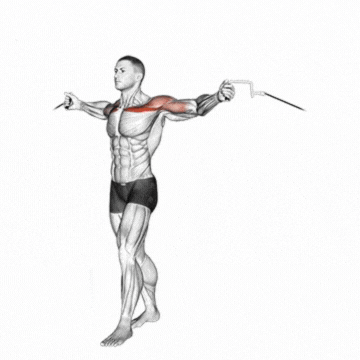Cable Crossover For Chest: Best Form, Faults & 5 Benefits
Learn how to perform cable crossover for upper chest and discover the benefits of this effective exercise for your chest muscles. Get step-by-step instructions, variations, and tips to make the most out of your cable crossover workout. Get fit with Learn For Fit.

How to Perform Cable Crossover for Upper Chest
To perform cable crossover for upper chest, you will need a cable machine with adjustable cables, and a pair of D-handles. Follow these steps to perform the exercise correctly:
Stand in the middle of the cable machine, and adjust the cables to the highest position.
Attach the D-handles to the cables and take one in each hand.
Lean forward slightly, and position your feet shoulder-width apart.
Bring your hands together in front of your chest, and cross them over each other. Your hands should be at the level of your upper chest.
Slowly pull the handles apart, keeping your arms straight, and extend them out to your sides. Keep your elbows slightly bent throughout the movement.
Pause for a moment, and then bring the handles back together in front of your chest.
Repeat for your desired number of reps.
Variations of Cable Crossover :
Low cable crossovers: Adjust the cables to the lowest position, and perform the same movement as described above. This variation targets the lower chest.
Incline cable crossovers: Adjust the cables to a low position, and set up an incline bench at a 45-degree angle in front of the cables. Lie back on the bench, and perform the cable crossovers exercise. This variation puts more emphasis on the upper chest.
Benefits of cable crossover
Builds upper chest: Cable crossover are one of the best exercises for targeting the upper chest muscles, which are often difficult to isolate with other chest exercises.
Works multiple muscle groups: Cable crossover also work the anterior deltoids, triceps, and other muscles in the chest and shoulders.
Improves strength: As a compound exercise, cable crossovers help to increase overall strength and muscle mass.
Improves muscle endurance: It help to improve muscle endurance by targeting both slow and fast-twitch muscle fibers.
Can be customized: By adjusting the height of the cable pulleys and the angle of your body, you can target different areas of your chest and shoulders.
Can be performed with different equipment: It can be performed with cable machines, resistance bands, or even dumbbells.
Offers variety: This is a great exercise to add variety to your chest workout routine and prevent boredom.
Reduces muscle imbalances: This can help to correct muscle imbalances by targeting both sides of the chest evenly.
Enhances mind-muscle connection: It requires focus and control, which helps to improve the mind-muscle connection and increase the effectiveness of the exercise.
Can be used for prehab and rehab: Cable crossover can be used for both prehabilitation and rehabilitation purposes to prevent or recover from injuries.
Conclusion
Cable crossover are an effective exercise for targeting the upper chest, as well as other muscles in the chest and shoulders. By using proper form and controlling your movements, you can maximize the benefits of this exercise. Incorporating cable crossover into your chest workout routine can help to increase strength, muscle mass, and endurance, while also improving muscle imbalances and the mind-muscle connection.
What does cable crossover do?
Cable crossover is a strength training exercise that targets the chest muscles, primarily the pectoralis major.
How effective is cable crossover?
It is effective in building chest strength and size, as well as improving upper body stability and coordination.
What is the difference between cable fly and crossover?
The main difference between cable fly and crossover is that cable fly is performed with arms extended in front of the body, while cable crossover involves crossing the arms in front of the body.
Is cable crossover good for beginners?
Cable crossover can be a challenging exercise for beginners, but can be adapted with lighter weights and proper form.
What muscles does Low Cable Crossovers work?
Cable crossover primarily targets the chest muscles, specifically the pectoralis major. However, it also engages other muscles in the upper body, including the anterior deltoids (shoulders), triceps, and biceps. Additionally, cable crossover can help improve upper body stability and coordination, working the core and other stabilizer muscles.

